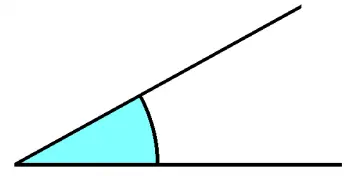
The convex angle is a type of angle that is defined based on its measurement. According to the classification of angles by measurement, the convex angle measures less than 180º or π. Therefore, its dimension is between a zero angle and a straight angle.
An angle is formed by two segments, straight lines or rays that intersect at a point called a vertex. The angle measurement determines the inclination of one segment with respect to the other.
On the other hand, the term convex refers to the concept by which a surface has a greater depression at the ends than in the center. For example, the surface of a ball has a convex shape.
How long is the convex angle?
There is no single measurement for a convex angle. However, all angles that measure less than 180º or π radians are convex.
The tool for graphically measuring angles is an angle protractor.
Properties
Convex angles have several distinctive characteristics that differentiate them from other types of angles. Here are some of its main features:
- Magnitude less than 180 degrees: Convex angles have a magnitude that is less than 180 degrees. This means that the angle opening does not extend beyond a straight line.
- Opening to the outside: Unlike concave angles, convex angles open to the outside. In other words, they do not have any portion that folds into the interior of the figure.
- External vertices: The vertices of a convex angle point outward from the figure, contributing to its opening to the outside.
- Sum of interior angles: In convex polygons (figures with straight sides), the sum of the interior angles is always less than 180 degrees.
- The difference between convex angle and concave angle is that the first is always less than 180 and the second is always greater than 180.
- The remaining angle that is formed by the exterior angle of the convex angle that is not a straight angle is a concave angle, which is one that measures between 180º and 360º. The sum of both angles forms a complete 360º angle.
- Convex polygons are defined as those in which all of their interior angles are convex. Therefore, all regular polygons are convex.
Classification
Depending on the magnitude, the three types of convex angles that divide them are:
-
Acute convex angle: The acute angle has a dimension less than 90º.
-
Obtuse convex angle: Obtuse angles measure between 90º and 180º.
-
Right convex angle: The right angle is that angle whose dimension is 90º.
everyday examples
Below are some illustrative examples of convex angles:
- Point of an arrow: The sharp point of an arrow forms a convex angle, highlighting the outward opening characteristic of this type of angle.
- Letter "V": The letter "V" itself forms a convex angle in its central part, where the arms of the letter open outwards.
- Separation of fingers: The space between the fingers of the hands creates convex angles, evidencing how the opening of the fingers contributes to the formation of exterior angles.
Examples in geometric figures
In general, any regular polygon (triangle, square, pentagon, etc.) and many other geometric shapes have convex angles.
Here are some examples:
- Square: All interior angles of a square measure exactly 90 degrees, so they are convex.
- Equilateral triangle: In an equilateral triangle, all interior angles measure 60 degrees, making them convex.
- Rectangle: In a rectangle, two of the interior angles measure 90 degrees, and the other two measure 90 degrees each, making them convex.
- Regular pentagon: In a regular pentagon, all interior angles measure 108 degrees, which are convex.